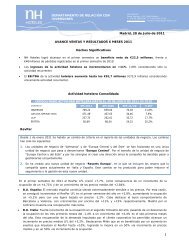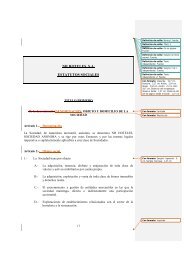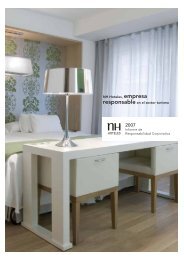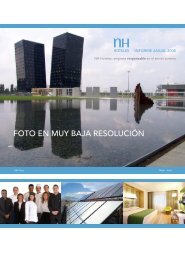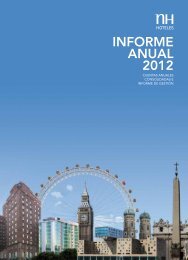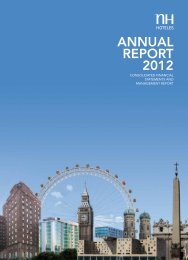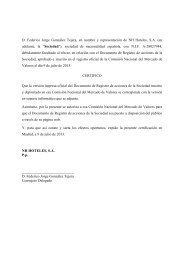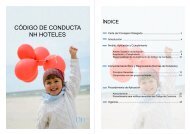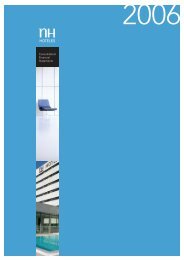Consolidated Financial Statements and Consolidated Management ...
Consolidated Financial Statements and Consolidated Management ...
Consolidated Financial Statements and Consolidated Management ...
Create successful ePaper yourself
Turn your PDF publications into a flip-book with our unique Google optimized e-Paper software.
4. VALUATION STANDARDS<br />
The main principles, accounting policies <strong>and</strong> valuation st<strong>and</strong>ards applied by the Group to draw up these consolidated financial statements, which comply with<br />
IFRS in force on the date of the relevant financial statements, are the following ones:<br />
4.1. Tangible fixed assets<br />
Tangible fixed assets are valued at their original cost. They are subsequently valued at their reduced cost resulting from cumulative depreciation <strong>and</strong>, as<br />
appropriate, from any impairment losses they may have suffered.<br />
Due to the transition to IFRS, the Group reappraised the value of some l<strong>and</strong> to its market value on the basis of appraisals made by an independent expert<br />
for a total amount of 217 million euros. The reappraised cost of such l<strong>and</strong> was considered as a cost attributed to the transition to the IFRS. The Group<br />
followed the criterion of not revaluing any of its tangible fixed assets at subsequent year-ends.<br />
Enlargement, modernization <strong>and</strong> improvement costs entailing an increase in productivity, capacity or efficiency or a lengthening of the assets’ useful life are<br />
booked as higher cost of such assets. Conservation <strong>and</strong> maintenance costs are charged against the consolidated comprehensive profit <strong>and</strong> loss statement<br />
for the year in which they are incurred.<br />
The Group depreciates its intangible fixed assets following the straight line method, distributing the cost of the assets over their estimated useful lives, in<br />
accordance with the following table:<br />
Estimated years of useful life<br />
Buildings 33-50<br />
Plant <strong>and</strong> machinery 10-30<br />
Other fixtures, tools <strong>and</strong> furniture 5-10<br />
Other fixed assets 4-5<br />
4.2. Real estate investments<br />
These reflect the l<strong>and</strong>, buildings <strong>and</strong> real estate constructions held either for rental or to obtain a capital gain on their sale.<br />
Real estate investments are valued at their original cost. Buildings are valued according to the cost of the corresponding certifications of the works<br />
executed plus any expenses associated with the project (works management, fees, architect’s fees, etc.) <strong>and</strong> depreciated on a straight-line basis depending<br />
on their useful life, which is the same as that used in tangible fixed assets for similar elements.<br />
Interest costs attributable to these investments are activated during the construction period up to the moment they are ready for sale <strong>and</strong> are considered<br />
as an increased investment cost. Should financial income be obtained from temporary investment of surpluses, said income reduces the cost of the<br />
investment.<br />
Revenue <strong>and</strong> gains or losses arising from the sale of the assets to buyers <strong>and</strong> the execution of deeds of sale, being the time at which the inherent rights<br />
<strong>and</strong> obligations are transferred, are recognised. Rental income is attributed to the results on an accrual basis.<br />
An accrual basis is used to recognise rental costs, charging all maintenance, management <strong>and</strong> depreciation costs of the rented assets to profit <strong>and</strong> loss.<br />
The Group periodically determines the fair value of real estate investment elements, using appraisals performed by independent experts as a reference.<br />
4.3. Consolidation goodwill<br />
Consolidation goodwill reflects excess acquisition cost when compared to the Group’s interest in the market value of the identifiable assets <strong>and</strong> liabilities<br />
of a subsidiary or jointly controlled entity on the date of acquisition.<br />
Any positive difference between the cost of interests in the capital of consolidated <strong>and</strong> associated entities <strong>and</strong> the corresponding theoretical book values<br />
acquired, adjusted on the date of the first consolidation, are recognised as follows:<br />
1. If they are assignable to specific equity elements of the companies acquired, by increasing the value of any assets whose market value is above their net<br />
book value appearing in the balance statements.<br />
2. If they are assignable to specific intangible assets, by explicitly recognising them in the consolidated balance sheet, provided their market value on the<br />
date of acquisition can be reliably determined.<br />
3. Any remaining differences are entered into the books as goodwill, which is assigned to one or more specific cash-generating units (in general hotels)<br />
which are expected to make a profit.<br />
Goodwill will only be booked when it has been acquired for valuable consideration.<br />
Any goodwill generated through the acquisition of associated companies is booked as an increased value of the interest.<br />
Any goodwill generated through acquisitions prior to the IFRS transitional date, 1 January 2004, is kept at its net value booked at 31 December 2003 in<br />
accordance with Spanish accounting st<strong>and</strong>ards.<br />
Goodwill is not depreciated. In this regard, the Group estimates, using the so-called “Impairment Test”, the possible existence of permanent losses of<br />
value that would reduce the recoverable value of goodwill to an amount less that the net cost booked at the end of each year <strong>and</strong> provided evidence of a<br />
loss of value exists. Should this be the case, they are written down in the consolidated comprehensive profit <strong>and</strong> loss statement. Any write-downs entered<br />
into the books cannot be subject to subsequent review.<br />
All goodwill is assigned to one or more cash-generating units in order to conduct the impairment test. The recoverable value of each cash-generating<br />
unit is determined either as the value in use or the net sale price that would be obtained for the assets assigned to the cash-generating unit, whichever is<br />
higher. The value in use is calculated on the basis of estimated future cash flows discounted at an after tax rate that reflects the current market valuation<br />
with respect to the cost of money <strong>and</strong> the specific risks associated with the asset.<br />
The discount rates used by NH Hoteles Group for these purposes range between 8.2% <strong>and</strong> 12%, depending on the different risks associated with each<br />
specific asset.<br />
REPORT ON THE CONSOLIDATED FINANCIAL STATEMENTS 71



